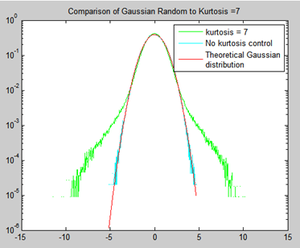Product Overview
The Random Vibration Control System provides precise, real-time, multi-channel control and analysis.
Random vibration testing supports up to 512 input channels. Users can enable up to 128 channels for control and notching. Users can designate the rest of the channels as monitoring and time data recording channels.
The recording option records time stream data at a full sample rate on all input channels. A unique hardware design provides a fast loop time of less than 15 ms. An optional Kurtosis control can create a non-Gaussian random signal. Annual updates are available through a convenient software subscription.
Learn More- Key Features
- Options
- Resources
- Request Quote
- Videos
- Specifications
- Hardware
- Software
- Drive Notching/Limiting
Key Features
- Displacement Optimization for Random:
A proprietary algorithm was developed to minimize displacement during Random Vibration Control testing. Displacement is reduced by 10% to 20% while the target PSD profile can still be reached. (Patent pending.) - Multi-resolution Function for Random Vibration Control:
EDM provides the multi-resolution feature that applies the selected resolution in the high-frequency range and 8 times of the resolution in the low-frequency range. The cutoff frequency, which divides the low and high-frequency range, is calculated by the software. (Patent pending.) - Control Dynamic Range in Random:
One of the key requirements for a random controller is to achieve high control dynamic range. Control dynamic range is a measure to compare the highest and lowest spectrum amplitude in the control signal. Spider vibration controllers can achieve at least 90 dB control dynamic range. This can be measured by a modified Chinese testing standard, JJG-948. The JJG-948 only requires a control dynamic range up to 60 dB. By modifying the noise floor to lower quantity we can show much higher control dynamic range.
Safety Features
- Abort Sensitivity: a single parameter allows the sensitivity and tolerance of various safety checks to be easily adjusted between customizable lower and upper bounds
- Shaker Safety Limits: limits for shaker acceleration, velocity, and displacement
- Open Loop Detection: open loop detection for the control signal and each input channel. Detection is based on maximum control loss or maximum RMS rate of change in the input channels.
- RMS Limits: RMS limits for control signal
- Control Spectral Limits: spectral limits for control signal, starts at full level or low level
- Max Drive Limit: maximum voltage limit for drive output
- Shutdown: user-defined shutdown rate in dB per second
- Sensor Response Detection: calculation of coherence signals between input channels and drive
Continuous Data Recording
During vibration control, all measurement input and drive signals can continuously record to a Spider-NAS or the internal storage residing in each front-end. Users can view and analyze data files with Crystal Instruments Post Analyzer. The variable sampling rate can be enabled to simultaneously record slow-change signals together with high speed vibration data.
Available Options
For further information on options available for this Product, please contact our specialist sales team on:
+44 (0) 1462 481859 or
Resources
Request Quote
Please select the form below relevant to your enquiry:
Videos
Specifications
- Frequency Range: up to 46 kHz
- Spectral Resolution: 200, 400, 800, 1,600, 3,200 and 6,400. 3,200 for all 8 channels. 25,600 optional.
- Spectral Resolution (Multi-Resolution is enabled): With Multi-Resolution enabled, equivalent resolutions of up to 25,600 lines for all 8 channels/module.
- Loop Time: 12.5 ms for 2000 Hz.
- Average Number: 1 – 500 (2 – 1000 DOFs)
- Overlap Ratio: none, 50%, 75%, and 87.5%
- Control Dynamic Range: 90 dB
- Control Accuracy: ±1 dB at 99% confidence with 200 DOF
- Drive Sigma Clipping: 3 – 10
Hardware
- Spider-81 Premium Vibration Controller
- Spider-81B Basic Vibration Controller
- Spider-80X High Channel Vibration Controller – Scale up to 512 Channels
- Spider-80Xi High Channel Vibration Controller – Compact, handheld high channel system
- Spider-80M – MIMO Vibration Control System
Software
- Sine-on-Random Vibration Control
- Random-on-Random Vibration Control
- Kurtosis Control for Vibration Testing
- Fatigue Damage Spectrum in Random
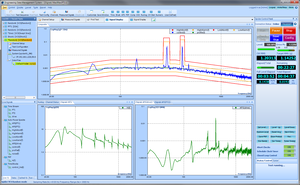
Sine on Random
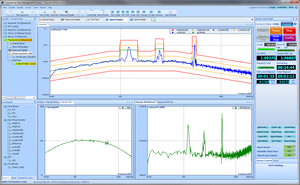
Random on Random
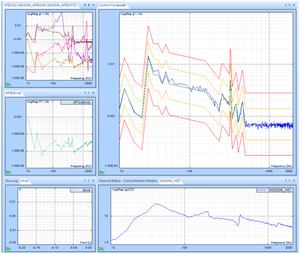
Multi-Resolution Control
Drive Notching/Limiting
Limiting is applied to control or monitor channels. Three types of limiting are available in Random Control: frequency domain, time domain, and advanced limit. Frequency domain limiting is spectrum limiting. Limit types are notching limit, abort limit, and alarm limit.
Time domain limiting compares raw data or the RMS value of input channels to the high limit. The occurrence of exceeding the high limit is one of the system events to which desirable actions can be added.
Advanced limit includes summed channel notching and vector notching. A summed virtual channel is defined as the weighted average of raw time stream signals from multiple input channels. The notch profile of a summed channel is defined in the frequency domain.
A vector RRS signal is defined as the vector sum of raw time stream signals from 3 input channels. The notch profile of a vector RRS signal is defined in the frequency domain as well.
Supports up to 128 notching/limiting channels out of 512 input channels.
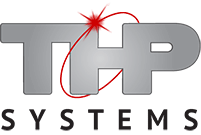

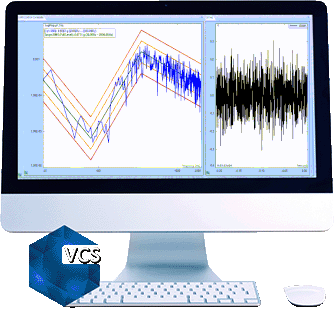
 VCS Brochure
VCS Brochure